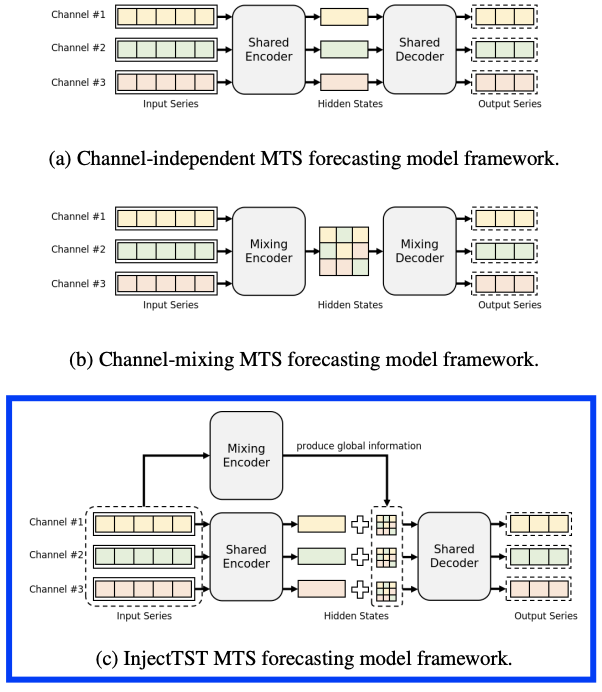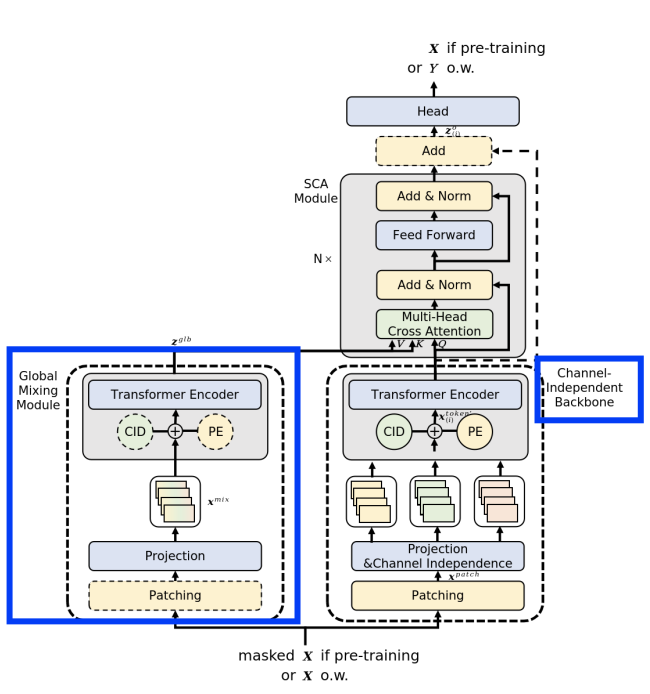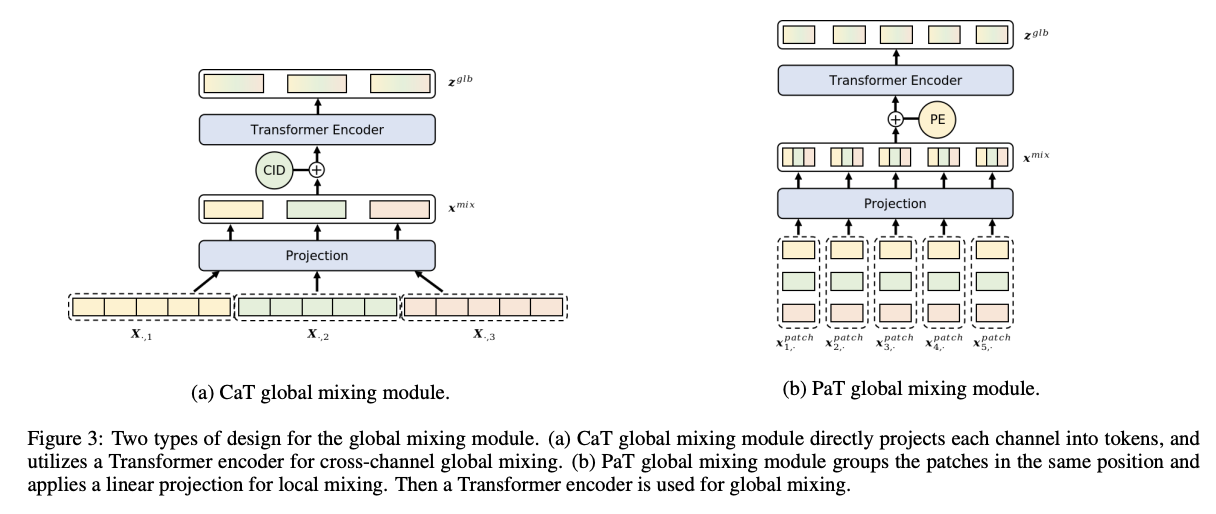InjectTST: A Transformer Method of Injecting Global Information into Independent Channels for Long Time Series Forecasting
Contents
- Abstract
- Introduction
- CI vs. CM
- InjectTST
- Contributions
- Methodology
- CI Backbone
- Global Mixing Module
- Self-Contextul Attention Module
0. Abstract
CI > CD??
Channel dependency remains an inherent characteristic of MTS,
Designing a model that incorporates merits of both
- (1) channel-independent
- (2) channel-mixing
InjectTST
Instead of designing a CM model,
Retain the CI backbone
& gradually inject global information into individual channels in a selective way
Modules
- (1) Channel identifier
- Help Transformer distinguish channels for better representation.
- (2) Global mixing module
- Produces cross-channel global information
- (3) Self-contextual attention module
- Independent channels can selectively concentrate on useful global information without robustness degradation, and channel mixing is achieved implicitly.
1. Introduction
(1) CI vs. CM
Advantages of CI
-
(1) Noise mitigation:
-
Focus on individual channel forecasting,
without being disturbed by noise from other channels
-
-
(2) Distribution drift mitigation:
- Alleviate the distribution drift problem of MTS
Advantages of CM
- (1) High information capacity:
- Excel in capturing channel dependencies
- Bring more information to the forecasting
- (2) Channel specificity:
- Carried out simultaneously, enabling the model to fully capture the distinct characteristics of each channel
Goal: design an effective model with merits of both CI & CD
Challenges of CI + CM
- (CI) Inherently contradictory to channel dependencies
- (CM) Existing denoising methods and distribution drift-solving methods still struggle to make CM frameworks as robust as CI
(2) InjectTST

Components
- (1) Channel identifier
- (2) Global mixing module
- (3) Self-contextual attention (SCA)
a) Channel identifier
- Trainable embedding for each channel
- extracting unique representation of channels
- Distinguishing channels for the Transformer in the injection period
b) Global mixing module
- Produce global information for subsequent injection
- Transformer encoder is used for a high-level global representation.
c) Self-contextual attention (SCA)
- For harmless information injection
- Context = Global information
- Injection via a modified cross attention , with minimal noise disturb.
(3) Contributions
-
Both CI & CM
-
CI as backbones
-
CM information is viewed as context
& injected into individual channels in a selective way
-
- Inject TST
- Injection MTS forecasting method for global information into CI Transformer models
- (1) Channel identifier: to identify each channel
- (2) Two kinds of global mixing modules: mix channel information effectively
- (3) Cross attention-based SCA module: to inject valuable global information into individual channels.
- Experiments
2. Methodology
Notation
- Input MTS \(\boldsymbol{X}=\left(\boldsymbol{x}_1, \boldsymbol{x}_2, \ldots, \boldsymbol{x}_L\right)\),
- \(\boldsymbol{x}_t=\) \(\left(x_{t, 1}, x_{t, 2}, \ldots, x_{t, M}\right), t=1,2, \ldots, L\).
- Target MTS \(\boldsymbol{Y}=\left(\boldsymbol{x}_{L+1}, \ldots, \boldsymbol{x}_{L+T}\right)\).

(1) CI Backbone
a) Patching and Projection
\(\boldsymbol{x}^{\text {token }}=\boldsymbol{x}^{\text {patch }} \boldsymbol{W}+\boldsymbol{U}\).
- where the output \(\boldsymbol{x}^{\text {token }} \in \mathbb{R}^{M \times P N \times D}\).
[Patching]
- Before) \(\boldsymbol{X} \in \mathbb{R}^{L \times M}\)
- After) \(\boldsymbol{x}^{\text {patch }} \in \mathbb{R}^{M \times P N \times P L}\),
- \(P L\) : the length of each patch
- \(P N\) : the number of patches in each channel
[Linear projection]
- Projection: \(\boldsymbol{W} \in \mathbb{R}^{P L \times D}\) ,
- Learnable positional encoding: \(\boldsymbol{U} \in \mathbb{R}^{P N \times D}\)
b) Channel Identifier
CI = treats channels with a shared model \(\rightarrow\) Cannot distinguish the channels ( = lacking channel specificity )
Channel identifier
\(\boldsymbol{x}^{\text {token' }}=\boldsymbol{x}^{\text {token }}+\boldsymbol{V}=\boldsymbol{x}^{\text {patch }} \boldsymbol{W}+\boldsymbol{U}+\boldsymbol{V} \text {. }\).
- Learnable tensor \(\boldsymbol{V} \in \mathbb{R}^{M \times D}\).
\(\boldsymbol{z}_{(i)}=\text { Encoder }^{\text {ci }}\left(\boldsymbol{x}_{(i)}^{\text {token' }}\right), i=1,2, \ldots, M\).
- \(\boldsymbol{x}^{\text {token' }}\) is input into the “CI” Transformer encoder
(2) Global Mixing Module
Input: \(\boldsymbol{X}\)
Goal: Produce global information & Inject into eaach channel
Two kinds of effective global mixing modules
- (a) CaT (channel as a token)
- (b) PaT (patch as a token)

a) CaT Global Mixing Module
Directly projects each channel into a token.
\(\boldsymbol{x}^{m i x}=\boldsymbol{X}^{\mathrm{T}} \boldsymbol{W}_{\text {mix }}\).
- \(\boldsymbol{W}_{\text {mix }} \in \mathbb{R}^{L \times D}\).
- \(\boldsymbol{x}^{m i x} \in \mathbb{R}^{M \times D}\).
Final global information
\(\boldsymbol{z}^{g l b}=\text { Encoder }{ }^{\text {mix }}\left(\boldsymbol{x}^{\text {mix }}+\boldsymbol{V}\right)\).
- channel identifier \(\boldsymbol{V}\)
b) PaT Global Mixing Module
Fuses information within the patch level
\(\boldsymbol{x}^{\text {mix }}=\boldsymbol{x}^{\text {patch }} \boldsymbol{W}_{\text {mix }}\).
- Reshapes the patches into dimensions of \(P N \times(M \cdot P L)\)
- \(\boldsymbol{W}_{\text {mix }} \in \mathbb{R}^{(M \cdot P L) \times D}\) is applied on the grouped patches.
- \(\boldsymbol{x}^{m i x} \in \mathbb{R}^{P N \times D}\).
Final global information
\(\boldsymbol{z}^{g l b}=\text { Encoder }^{\text {mix }}\left(\boldsymbol{x}^{\text {mix }}+\boldsymbol{U}\right)\).
- positional encoding \(\boldsymbol{U}\)
\(\rightarrow\) PaT is more stable, while CaT is outstanding in some special datasets
(3) Self-Contextual Attention Module
Must inject global information into each channel ***with minimal impact on the robustnessv
\(\rightarrow\) use cross attention
\(\boldsymbol{z}_{(i)}^o=\operatorname{SCA}\left(\boldsymbol{z}_{(i)}, \boldsymbol{z}^{g l b}, \boldsymbol{z}^{g l b}\right)\).
- [K,V] context \(\boldsymbol{z}^{g l b}\)
- [Q] channel information \(\boldsymbol{z}_{(i)}\)
Others
-
Finally, a linear head is appended to produce the prediction
-
SSL as PatchTST
